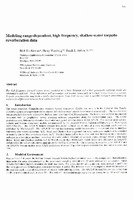| dc.contributor.author | Keenan, Ruth Eta | |
| dc.contributor.author | Weinberg, Henry | |
| dc.contributor.author | Aidala, Frank E. | |
| dc.date.accessioned | 2018-10-11T14:08:15Z | |
| dc.date.available | 2018-10-11T14:08:15Z | |
| dc.date.issued | 1997 | |
| dc.identifier | 11479 | |
| dc.identifier.govdoc | CP-45 | |
| dc.identifier.uri | http://hdl.handle.net/20.500.12489/434 | |
| dc.description.abstract | The high-frequency, forward bottom losses predicted by a lossy Rayleigh and a Biot poroelastic sediment model are substantially different. These differences will accumulate and become measurable in multiple bottom bounce scenarios. Torpedo reverberation data from a sandy, shallow-water Cape Cod site provides a suitable multipath environment to examine the differences between these sediment models. | |
| dc.format | 7 p. : ill. ; digital, PDF file | |
| dc.language | English | |
| dc.publisher | NATO. SACLANTCEN | |
| dc.source | In: High Frequency Seafloor Acoustics (SACLANTCEN Conference Proceedings CP-45), 1997, pp. 291-298 | |
| dc.subject | High Frequency Acoustics | |
| dc.subject | Acoustic reverberation | |
| dc.subject | Transmission loss | |
| dc.subject | Shallow water | |
| dc.subject | Seafloor sediments | |
| dc.subject | Torpedoes | |
| dc.subject | Modelling and environmental measurements | |
| dc.title | Modeling range-dependent, high-frequency, shallow-water torpedo reverberation data | |
| dc.type | Papers and Articles | |
| dc.type | Conference Proceedings (CP) | |
